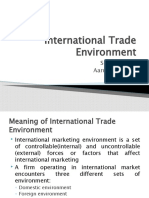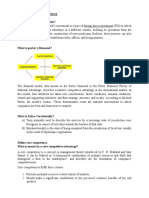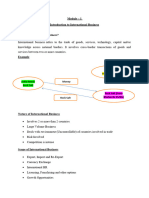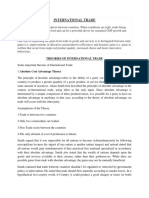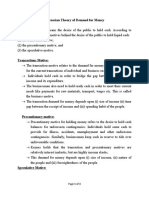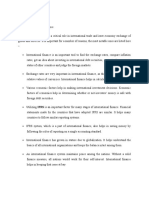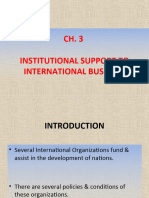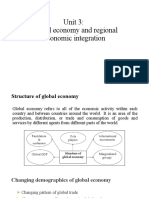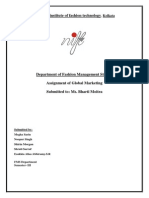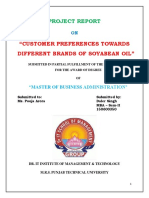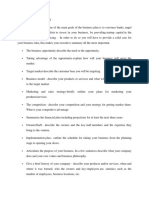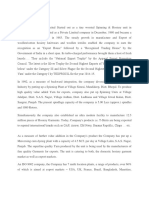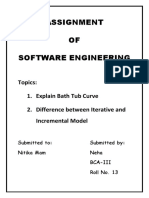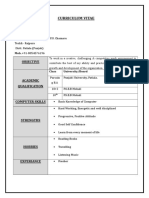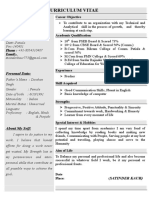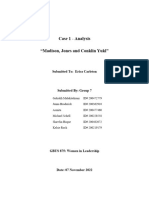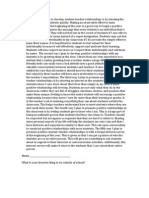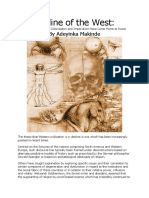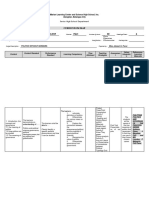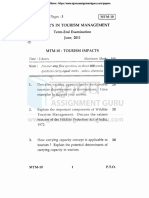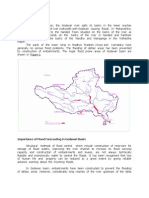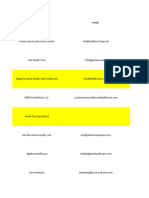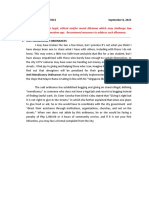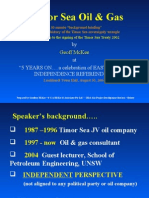INTRODUCTION TO TRADE BLOCS
A trade bloc is a type of intergovernmental agreement, often part of a regional
intergovernmental organization, where regional barriers to trade, (tariffs and nontariff
barriers) are reduced or eliminated among the participating states. Historic economic
blocs include the Hanseatic League, a trading alliance in northern Europe in existence
between the 13th and 17th centuries and the German Customs Union (Zollverein)
initiated in 1834, formed on the basis of the German Confederation and subsequently
German Empire from 1871. Surges of trade bloc formation were seen in the 1960s and
1970s, as well as in the 1990s after the collapse of Communism. By 1997, more than
50% of all world commerce was conducted within regional trade blocs. Economist
Jeffrey J. Scott of the Peterson Institute for International Economics notes that members
of successful trade blocs usually share four common traits: similar levels of per capita
GNP, geographic proximity, similar or compatible trading regimes, and political
commitment to regional organization.
Advocates of worldwide free trade are generally opposed to trading blocs, which, they
argue, encourage regional as opposed to global free trade. Scholars and economists
continue to debate whether regional trade blocs are leading to a more fragmented world
economy or encouraging the extension of the existing global multilateral trading system.
Trade blocs can be stand-alone agreements between several states (such as the North
American Free Trade Agreement (NAFTA)) or part of a regional organization (such as
theEuropean Union). Depending on the level of economic integration, trade blocs can fall
1
�into different categories, such aspreferential trading areas, free trade areas, customs
unions, common markets and economic and monetary unions.
OBJECTIVE OF TRADING BLOCS
A bloc means groups. Trading blocs means grouping of countries. It means a group of
nations united for some common actions. Trading bloc is a voluntary grouping of
countries of a specific region for common benefit. It indicates regional economic
integration of nations for mutual benefits. In general terms, regional trade blocks are
associations of nations to promote trade within the block and defend its members against
global competition. Trading blocs are highly organised and based on shared interest to
promote economic and social interest of the member countries. There are different types
of trading blocs such as Free Trade Area, Customs union, Economic Union, custom
union, political union, common market etc. trading blocs leads to greater international
bargaining power, increased competition between members, rapid spread of technology
etc. Lowering trade barriers is one of the most obvious means of encouraging trade.
OBJECTIVES OF TRADING BLOCS:
i. To remove trade restrictions among member nations.
ii. To improve social, political, economic and cultural relations among member
nations.
iii. To encourage free transfer of resources.
iv. To establish collective bargaining.
2
� v. To promote economic growth.
SAARC:
It stands for South Asian Association for Regional Cooperation. SAARC is an economic
integration of South Asian countries for regional cooperation. It was established on 8 th
December 1985.
It consists of nations of South Asia that includes Bangladesh, Bhutan, India, Maldives,
Nepal, Pakistan and Srilanka. SAARC focus on areas such as Science and Technology,
agricultural and rural development, tele-communication, postal services etc.
SAARC members signed an agreement called SAPTA (South Asian Preferential Trade
Agreement). This agreement was signed to provide a framework for the exchange of
trade concessions
It aims at accelerating the process of economic and social development in member states.
Afghanistan became the eighth member of this group in 2007.
OPEC: Oil and Petroleum exporting countries:
Opec is an organization consisting of world's oil and petroleum exporting countries. The
Organization of the Petroleum Exporting Countries (OPEC) was created in 1960 to unify
and protect the interests of oil-producing countries. OPEC has maintained its
headquarters in Vienna since 1965.
3
�The original members of OPEC included Iran, Iraq, Kuwait, Saudi Arabia, and
Venezuela. OPEC has since expanded to include seven more countries (Algeria, Angola,
Indonesia, Libya, Nigeria, Qatar, and United Arab Emirates) making a total membership
of 12.
The main objective of this bloc is to unify and coordinate member countries petroleum
policies and to provide them with technical and economic aid. There has been a
continuous increase in India's share of export to opec countries.
EU - European Union:
European Union is considered as one of the powerful trading bloc in the world. It was
brought into existence in 1st January 1958 by the treaty of Rome. France, Western
Germany, Italy, Belgium, Netherland and Luxemburg were the founder members of
European Union. Initially it was known as European Economic Community (EEC).
It has a common currency called 'EURO'. It also offers tremendous trade opportunities
for non-European firms. At present there are twenty seven members in this bloc that
includes: Austria, Belgium, Bulgaria, Cyprus, the Czech Republic, Denmark, Estonia,
Finland, France, Germany, Greece, Hungary, Ireland, Italy, Latvia, Lithuania,
Luxembourg, Malta, the Netherlands, Poland, Portugal, Romania, Slovakia, Slovenia,
Spain, Sweden, and the United Kingdom.
4
�NAFTA:
North American Free Trade Agreement the North American Free Trade Agreement or
NAFTA is an agreement signed by the governments of the United States, Canada, and
Mexico creating a trilateral trade bloc in North America.
The agreement came into force on January 1,1994 NAFTA is the most powerful trading
blocs in the world. USA, Canada, Mexico are the members of NAFTA. The objective of
NAFTA is to reduce barriers on the flow of goods, services and people among member
nations, protection to investment in member countries etc. European Union and NAFTA
accounts for over fifty percent of the world trade.
ADVANTAGES AND DISADVANTAGES OF TRADE BLOCS
There are five major advantages of trade bloc agreements: foreign direct investment,
economies of scale, competition, trade effects, and market efficiency.
Foreign Direct Investment: An increase in foreign direct investment results from trade
blocs and benefits the economies of participating nations. Larger markets are created,
resulting in lower costs to manufacture products locally.
Economies of Scale: The larger markets created via trading blocs permit economies of
scale. The average cost of production is decreased because mass production is allowed.
5
�Competition: Trade blocs bring manufacturers in numerous countries closer together,
resulting in greater competition. Accordingly, the increased competition promotes greater
efficiency within firms.
Trade Effects Trade blocs eliminate tariffs, thus driving the cost of imports down. As a
result, demand changes and consumers make purchases based on the lowest prices,
allowing firms with a competitive advantage in production to thrive.
Market Efficiency: The increased consumption experienced with changes in demand
combines with a greater amount of products being manufactured to result in an efficient
market. The disadvantages, on the other hand, include: regionalism vs. multinationalism,
loss of sovereignty, concessions, and interdependence.
Regionalism vs. Multinationalism: Trading blocs bear an inherent bias in favor of their
participating countries. For example, NAFTA, a free trade agreement between the United
States, Canada and Mexico, has contributed to an increased flow of trade among these
three countries. Trade among NAFTA partners has risen to more than 80 percent of
Mexican and Canadian trade and more than a third of U.S. trade, according to a 2009
report by the Council on Foreign Relations. However, regional economies by establishing
tariffs and quotas that protect intra-regional trade from outside forces, according to the
University of California Atlas of Global Inequality. Rather than pursuing a global trading
regime within theWorld Trade Organization, which includes the majority of the world's
countries, regional trade bloc countries contribute to regionalism rather than global
integration.
6
�Concessions: No country wants to let foreign firms gain domestic market share at the
expense of local companies without getting something in return. Any country that wants
to join a trading bloc must be prepared to make concessions. For example, in trading
blocs that involve developed and developing countries, such as bilateral agreements
between the U.S. or the EU and relatively poor Asian, Latin American or African
countries, the latter may have to allow multinational corporations to enter their home
markets, making some local firms uncompetitive.
Interdependence: Because trading blocs increase trade among participating countries,
the countries become increasingly dependent on each other. A disruption of trade within a
trading bloc as a result of a natural disaster, conflict or revolution may have severe
consequences for the economies of all participating countries.
REGIONAL TRADE BLOCKS, TARIFFS AND TRADE BARRIERS
The Internet and technological advances in telecommunications link trade partners
across the globe.
Yet, this does not mean that trade barriers are non-existent. While the World Trade
Organization (WTO) promotes global multilateral free trade, regional trade blocks
provide their members with the mechanisms for competing in an aggressive global
market.
Regardless of the size of your business, it is essential to know the international trade
regulations that govern your import and/or export operations. This article provides a brief
7
�description of each trade block – date established, list of members, goals, population, and
GDP (PPP). Links are provided for more detailed information of trade agreements and
tariffs.
REGIONAL TRADE BLOCKS
In general terms, regional trade blocks are associations of nations at a governmental
level to promote trade within the block and defend its members against global
competition. Defense against global competition is obtained through established tariffs
on goods produced by member states, import quotas, government subsidies, onerous
bureaucratic import processes, and technical and other non-tariff barriers.
Since trade is not an isolated activity, member states within regional blocks also
cooperate in economic, political, security, climatic, and other issues affecting the region.
In terms of their size and trade value, there are four major trade blocks and a larger
number of blocks of regional importance.
The four major regional trade blocks are, as follows:
ASEAN (Association of Southeast Asian Nations) Updated 22 Jan
2014 Established on August 8, 1967, in Bangkok/Thailand.
Member States: Brunei Darussalam, Cambodia, Indonesia, Laos, Malaysia,
Myanmar, Philippines, Singapore, Thailand, and Vietnam.
8
�ASEAN Economic Community (AEC): Learn more about ASEAN Leaders'
vision to transform ASEAN into a single market and production base that is highly
competitive and fully integrated into the global ecomony by 2015.
EU (European Union) Updated 22 Jan 2014
Founded in 1951 by six neighboring states as the European Coal and Steel
Community (ECSC).
Over time evolved into the European Economic Community, then the European
Community and, in 1992, was finally transformed into the European Union.
Regional block with the largest number of members states (28). These include Austria,
Belgium, Bulgaria, Croatia (2013), Cyprus, Czech Republic, Denmark, Estonia, Finland,
France, Germany, Greece, Hungary, Ireland, Italy, Latvia, Lithuania, Luxembourg,
Malta, Poland, Portugal, Romania, Slovakia, Slovenia, Spain, Sweden, The Netherlands,
and the United Kingdom.
MERCOSUR (Mercado Comun del Cono Sul - Southern Cone Common Market)
Official site is available only in Spanish and Portuguese.Updated 23 Jan 2014
Established on 26 March 1991 with the Treaty of Assunción.
Full members include Argentina, Brazil, Paraguay, Uruguay, and Venezuela. Boliivia
is undergoing process of becoming a full member. Associate members include Chile,
Colombia, Ecuador, Guyana, Peru, and Suriname. Associate members have access to
9
�NAFTA (North American Free Trade Agreement) Updated 27 Jan
2014 Agreement signed on 1 January 1994.
Members: Canada, Mexico, and the United States of America.
Goals: Eliminate trade barriers among member states, promote conditions for free
trade, increase investment opportunities, and protect intellectual property rights.
TYPES OF TRADING BLOCS
A regional trading bloc is a group of countries within a geographical region that protect
themselves from imports from non-members. Trading blocs are a form of economic
integration, and increasingly shape the pattern of world trade. There are several types of
trading bloc:
Preferential Trade Area
Preferential Trade Areas (PTAs) exist when countries within a geographical region agree
to reduce or eliminate tariffbarriers on selected goods imported from other members of
the area. This is often the first small step towards the creation of a trading bloc.
Free Trade Area
Free Trade Areas (FTAs) are created when two or more countries in a region agree to
reduce or eliminate barriers to trade on all goods coming from other members.
10
�Customs Union
A customs union involves the removal of tariff barriers between members, plus the
acceptance of a common (unified) external tariff against non-members. This means that
members may negotiate as a single bloc with 3rd parties, such as with other trading blocs,
or with the WTO.
Common Market
A ‘common market’ is the first significant step towards full economic integration, and
occurs when member countries trade freely in all economic resources – not just tangible
goods. This means that all barriers to trade in goods, services, capital, and labour are
removed. In addition, as well as removing tariffs, non-tariff barriers are also reduced and
eliminated. For a common market to be successful there must also be a significant level
of harmonisation of micro-economic policies, and common rules regarding monopoly
power and other anti-competitive practices.
The European Union (EU)
The EU is the world’s largest trading bloc, and second largest economy, after the USA.
The EU was originally called the Economic Community (Common Market, or The Six)
after Its formation following theTreaty of Rome in 1957. The original six members
were Germany, France, Italy, Belgium, Netherlands, and Luxembourg.
The initial aim was to create a single market for goods, services, capital, and labour by
eliminating barriers to trade and promoting free trade between members.
11
�In terms of dealing with non-members, common tariff barriers were erected against cheap
imports, such as those from Japan, whose goods prices were artificially low because of
the undervalued yen.
By 2014, following continuous enlargement, the EU had 28 members. Croatia is the latest
country to join, in July 2013.
The main advantages for members of trading blocs
Free trade within the bloc
Knowing that they have free access to each other's markets, members are encouraged to
specialise. This means that, at the regional level, there is a wider application of the
principle of comparative advantage.
Market access and trade creation
Easier access to each other’s markets means that trade between members is likely to
increase. Trade creation exists when free trade enables high cost domestic producers to
be replaced by lower cost, and more efficient imports. Because low cost imports lead to
lower priced imports, there is a 'consumption effect', with increased demand resulting
from lower prices.
THE MAIN DISADVANTAGES OF TRADING BLOCS
Loss of benefits
The benefits of free trade between countries in different blocs is lost.
12
�Distortion of trade
Trading blocs are likely to distort world trade, and reduce the beneficial effects of
specialisation and the exploitation ofcomparative advantage.
Inefficiencies and trade diversion
Inefficient producers within the bloc can be protected from more efficient ones outside
the bloc. For example, inefficient European farmers may be protected from low-cost
imports from developing countries. Trade diversion arises when trade is diverted away
from efficient producers who are based outside the trading area.
TRADE BARRIES
Trade barriers are government-induced restrictions on international trade.[1] The barriers
can take many forms, including the following:
Tariffs
Non-tariff barriers to trade
Import licenses
Export licenses
Import quotas
Subsidies
Voluntary Export Restraints
13
� Local content requirements
Embargo
Currency devaluation[2]
Trade restriction
Most trade barriers work on the same principle: the imposition of some sort of cost on
trade that raises the price of the traded products. If two or more nations repeatedly use
trade barriers against each other, then a trade war results.
Economists generally agree that trade barriers are detrimental and decrease overall
economic efficiency, this can be explained by the theory of comparative advantage. In
theory, free trade involves the removal of all such barriers, except perhaps those
considered necessary for health or national security. In practice, however, even those
countries promoting free trade heavily subsidize certain industries, such as agriculture
and steel.
Trade barriers are often criticized for the effect they have on the developing world.
Because rich-country players call most of the shots and set trade policies, goods such as
crops that developing countries are best at producing still face high barriers. Trade
barriers such as taxes on food imports or subsidies for farmers in developed economies
lead to overproduction and dumping on world markets, thus lowering prices and hurting
poor-country farmers. Tariffs also tend to be anti-poor, with low rates for raw
commodities and high rates for labor-intensive processed goods. The Commitment to
14
�Development Index measures the effect that rich country trade policies actually have on
the developing world.
Another negative aspect of trade barriers is that it would cause a limited choice of
products and would therefore force customers to pay higher prices and accept inferior
quality. Trade barriers may occur in international trade when goods have to cross political
boundaries. A trade barrier is a restriction on what would otherwise be free trade. The
most common form of trade barriers are tariffs, or duties (the two words are often used
interchangeably in the context of international trade), which are usually imposed on
imports. There is also a category of nontariff barriers, also known as nontariff measures,
which also serve to restrict global trade.
There are several different types of duties or tariffs. An export duty is a tax levied on
goods leaving a country, while an import duty is charged on goods entering a country. A
duty or tariff may be categorized according to how it is calculated. An ad valorem tariff
is one that is calculated as a percentage of the value of the goods being imported or
exported. For example, a 20 percent ad valorem duty means that a duty equal to 20
percent of the value of the goods in question must be paid. Duties that are calculated in
other ways include a specific duty, which is based on the quantity, weight, or volume of
goods, and a compound duty (also known as a mixed tariff), which is calculated as a
combination of an ad valorem duty and a specific duty.
Duties and tariffs are also categorized according to their function or purpose. An
antidumping duty is imposed on imports that are priced below fair market value and that
15
�would damage domestic producers. Antidumping duties are also called punitive tariffs. A
countervailing duty, another type of punitive tariff, is levied after there has been
substantial or material damage done to domestic producers. A countervailing duty is
specifically charged on imports that have been subsidized by the exporting country's
government. The purpose of a countervailing duty is to offset the subsidy and increase
the domestic price of the imported product.
A prohibitive tariff, also known as an exclusionary tariff, is designed to substantially
reduce or stop altogether the importation of a particular product or commodity. It is
typically used when the amount of an imported good exceeds a certain permitted level. It
may be used to protect domestic producers. Another type of tariff is the end-use tariff,
which is based on the use of an imported product. For example, the same product may be
charged a different duty if it is intended for educational use as opposed to commercial
use.
In addition to duties and tariffs, there are also nontariff barriers (NTBs) to international
trade. These include quantitative restrictions, or quotas, that may be imposed by one
country or as the result of agreements between two or more countries. Examples of
quantitative restrictions include international commodity agreements, voluntary export
restraints, and orderly marketing arrangements.
16
�Administrative regulations constitute a second category of NTBs. These include a variety
of requirements that must be met in order for trade to occur, including fees, licenses,
permits, domestic content requirements, financial bonds and deposits, and government
procurement practices. The third type of NTB covers technical regulations that apply to
such areas as packaging, labeling, safety standards, and multilingual requirements.
In 1980 the Agreement on Technical Barriers to Trade, also known as the Standards
Code, came into effect for the purpose of ensuring that administrative and technical
practices do not act as trade barriers. By the end of 1988 the agreement had been signed
by 39 countries. Additional work on promoting unified standards to eliminate these NTBs
was conducted by the General Agreement on Tariffs and Trade (GATT) Standards
Committee, which in 1994 was succeeded by the newly created World Trade
Organization (WTO). As a result more than 131 governments accepted the provisions of
the Technical Barriers to Trade (TBT) Agreement enforced by the WTO.
Standards and testing practices can become technical barriers to trade when they are
developed by national or regional interests and then imposed on the international trading.
The U.S. Department of Commerce' s 1998 report, "National Export Strategy," identified
"the global manipulation of international standards and testing practices by governments
and regional economic blocs" as a major threat to U.S. competitiveness abroad. Under the
TBT Agreement the WTO is supposed to guarantee due process and transparency in the
establishment of international standards. The Department of Commerce, however, has
presented examples where narrow regional or market interests have resulted in standards
17
�forced on international trade, and governments and regional economic blocs such as the
European Union (EU) have openly used standards and related practices to achieve market
domination. The United States was among those countries calling for technology- and
trade neutral standards, especially for markets in Latin America and Asia.
Other types of existing technical trade barriers include environmental, health, and safety
certification requirements. In Europe such requirements range from banning imported
beef from cattle raised with hormones to not allowing older airplanes to land because of
noise pollution concerns.
18
�CONCLUISON
Trade barriers may occur in international trade when goods have to cross political
boundaries. A trade barrier is a restriction on what would otherwise be free trade. The
most common form of trade barriers are tariffs, or duties (the two words are often used
interchangeably in the context of international trade), which are usually imposed on
imports. There is also a category of nontariff barriers, also known as nontariff measures,
which also serve to restrict global trade. Tariffs and other trade barriers have a definite
effect on consumption and production. They serve to reduce consumption of the imported
product, because the tariff raises the domestic price of the import. They also serve to
stimulate domestic production of the product when that is possible, also because of the
higher domestic price. Proponents of tariffs argue that such an increase in domestic
production is desirable, while opponents argue that it is inefficient from an economic
standpoint. The overall effect of tariffs and trade barriers on international trade is to
reduce the volume of trade and to increase the prices of imports. Proponents of free trade
argue that both of those results are undesirable, while proponents of protectionism argue
that tariffs may be necessary for a variety of reasons.
19





